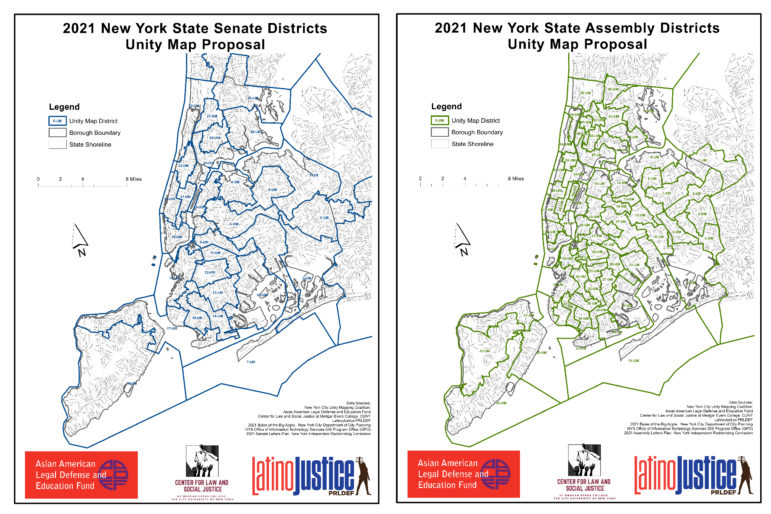The “Unity Map” was drawn by three civil rights legal groups—the Asian American Legal Defense Fund, the Center for Law and Social Justice, and Latino Justice—and features districts drawn to preserve a community’s political power, the organizers said, particularly important given the growth of the Asian population in the city according to last year’s census.

Courtesy of APA Voice
The “Unity Map” version of New York’s State Senate and Assembly districts.A coalition of New York City civic groups is urging Gov. Kathy Hochul and the state legislature to adopt the “Unity Map”—a draft redistricting map developed by civil rights groups instead of those created by the state Independent Redistricting Commission (IRC).
In a Monday afternoon press conference, organizers of several groups, including the MinKwon Center for Community Action and the Chinese-American Planning Council, criticized the redistricting commission’s process of drawing its map, which culminated in a partisan stalemate and two different sets of draft maps being sent to the state legislature earlier Monday.
“We are disappointed, but we are not surprised by the IRC being deadlocked,” said Liz OuYang, coordinator of Asian Pacific Americans Voting and Organizing to Increase Civic Engagement (APAVOICE), a group of nearly 20 organizations aimed at increasing Asian American representation in civic life.
“This is what happens when a 10-person, so-called independent commission is created that is split even along party lines,” OuYang added. “There were no additional independently chosen commissioners to serve as a tiebreaker. Yet we the public were forced to participate in this charade.”
While redistricting follows every census, New Yorkers voted to change the state’s process of drawing districts in 2014, creating the IRC, a 10-person commission with members appointed by Assembly and Senate leaders, who each get to appoint two representatives. The final two members are selected by the eight appointees.
Seven members must approve a plan, but in the event that threshold is not met, the plan with the most votes is sent to the state legislature. In this case, both plans were sent to lawmakers to approve, as the commissioners had not selected one.
As an alternative to those options, the “Unity Map” was drawn by three civil rights legal groups—the Asian American Legal Defense Fund, the Center for Law and Social Justice at Medgar Evers College, and Latino Justice—and features districts drawn to preserve a community’s political power, and not fragment it by dividing neighborhoods into multiple districts, its creators said.
“The Unity Map Coalition represents diverse communities of interest from all across New York City,” said Lurie Daniel Favors, executive director of the Center for Law and Social Justice at Medgar Evers, in a statement to City Limits.
“Communities that include New Yorkers of different racial and ethnic groups, political leanings, and socioeconomic backgrounds. With these interests in mind, the Unity Map Coalition produced its Congressional, State Senate, and State Assembly maps which facilitate the equitable distribution of power and maintain communities of interest,” Favors added. “Our maps align with best practices and adhere to long recognized redistricting principles.”
The effort is particularly important, the advocates said, given the growth of the Asian population in the city according to last year’s census. The Asian and Pacific Islander community in Brooklyn grew most notably, with a 43 percent increase, and 29 percent in Queens in the past 10 years.
“We have seen surges of the AAPI community not only in New York City, but in every county across the state of New York,” said Wayne Ho, president and chief executive of the Chinese-American Planning Council.
While coalition members at Monday’s press conference said that the IRC draft maps did include some of their input given during last year’s public comment process, initial analyses of the draft maps suggest they did not fully remedy some of the issues relayed by members of the community.
“We look at … the whole map to make sure all of the communities that are protected under the Voting Rights Act had fair maps and had their communities kept whole to the extent possible,” said Jerry Vattamala, director of the democracy program at the Asian American Legal Defense Fund, on Monday. “And what we found was that the Unity Map, just at every legislative level, overall did a much better job at keeping all these communities whole and together where possible.”
“Overall,” Vattamala added, “the Unity plan is still much better than both of those plans that were put out today.”
Examples from current district maps illustrate the gravity of the problem the Unity Map is trying to address, some said. In the past decade, “Little Manila” in Woodside, Queens, which is home to many Filipinos, “has been divided between at least three state assembly districts,” said Rachelle Ocampo, the chair of the National Federation of Filipino American Associations New York.
“That has diluted our voice and our power,” she added.
Sunset Park in Brooklyn and Flushing in Queens are other examples, the advocates said on Monday. While Sunset Park, where many Asian Americans live, has been divided into four state Senate districts over the last 10 years, the Unity Map would instead make it one district, the first Asian majority state Senate district in Sunset Park.
“Over the years, the South Asian community has spread all over Queens, in most of it but in Flushing it is robust,” said Sudha Acharya, the executive director of the South Asian Council for Social Services, which offers senior services and health care access programming. “But the way the map is now, they’re divided between Assembly District 25 and Assembly District 40, in jagged lines.”
In a Monday letter, the coalition also asked state lawmakers to provide another public comment opportunity after they have drawn their draft maps for the governor to approve. Local legal groups, including the Asian-American Bar Association and Latino Justice, have signed on, as have pro-democracy groups like Common Cause NY.
The state legislature has a chance to approve any of the draft maps, or create their own map before sending it to the governor.
The Center for Urban Research at CUNY’s Graduate Center has created an interactive tool that allows users to compare the various draft maps, including the Unity Map and the two proposed by the IRC. You can view those here.










One thought on “As NY Redistricting Forges Forward, Asian American Groups Push for ‘Unity Map’”
As Charles LaCerra and I vividly demonstrated some time ago by looking closely at
Ethnicity and Machine Politics: The Madison Club of Brooklyn. With (1992), there is no such thing as ‘good’ ethnic/racial/religious gerrymandering.